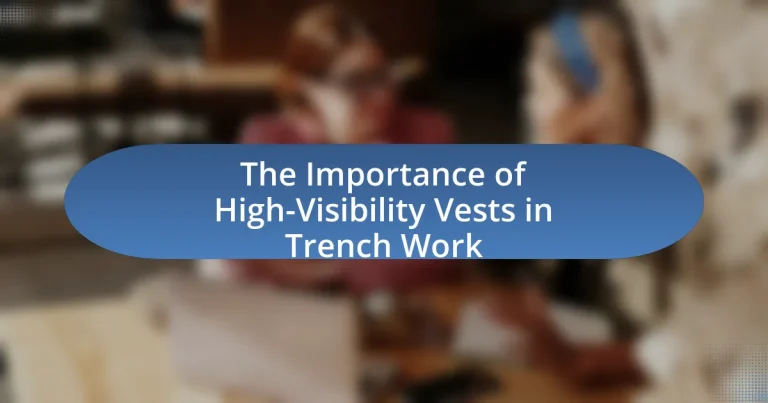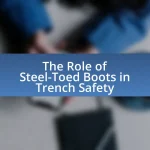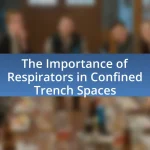High-visibility vests are essential safety garments in trench work, designed to enhance worker visibility and reduce the risk of accidents in hazardous environments. The article outlines the importance of these vests, detailing how their bright colors and reflective materials improve safety by making workers easily identifiable to machinery operators. It also discusses the regulations governing their use, the different classes of vests suitable for various conditions, and best practices for maintenance and proper usage. Additionally, the article highlights the potential risks of not wearing high-visibility vests and provides insights into selecting the right vest for trench work, ensuring compliance with safety standards.

What are High-Visibility Vests and Why are They Important in Trench Work?
High-visibility vests are safety garments designed to enhance the visibility of workers, particularly in environments where they may be at risk of being overlooked by machinery or vehicles. In trench work, these vests are crucial because they significantly reduce the likelihood of accidents by making workers easily identifiable to operators of heavy equipment. According to the Occupational Safety and Health Administration (OSHA), wearing high-visibility clothing can decrease the risk of accidents in construction zones, where visibility is often compromised. This is particularly important in trench work, where workers are often in close proximity to moving vehicles and equipment, making their visibility a key factor in ensuring safety on the job site.
How do High-Visibility Vests enhance safety in trench work?
High-visibility vests enhance safety in trench work by making workers easily identifiable in low-light or hazardous conditions. The bright colors and reflective materials of these vests increase visibility to operators of heavy machinery and other workers, reducing the risk of accidents. According to the Occupational Safety and Health Administration (OSHA), high-visibility clothing is essential in construction zones, where the likelihood of accidents is significantly higher. Studies show that wearing high-visibility apparel can decrease the chances of being struck by vehicles or equipment, thereby improving overall safety in trench environments.
What features make High-Visibility Vests effective for visibility?
High-Visibility Vests are effective for visibility due to their bright colors and reflective materials. The use of fluorescent colors, such as neon yellow or orange, enhances visibility in various lighting conditions, making the wearer easily noticeable. Additionally, the incorporation of reflective strips or tape increases visibility during low-light situations, such as dusk or nighttime. Studies have shown that wearing high-visibility clothing can reduce the risk of accidents by up to 30%, highlighting the importance of these features in ensuring safety in environments like trench work.
How do color and reflective materials contribute to safety?
Color and reflective materials enhance safety by increasing visibility in various environments. High-visibility colors, such as neon yellow or orange, stand out against backgrounds, making individuals more noticeable to others, especially in low-light or hazardous conditions. Reflective materials, which bounce light back to its source, further amplify visibility at night or in poor weather, ensuring that workers are seen from greater distances. Studies have shown that wearing high-visibility clothing can reduce accidents by up to 50% in construction and roadwork settings, underscoring the critical role these materials play in preventing injuries and fatalities.
What regulations govern the use of High-Visibility Vests in trench work?
The regulations governing the use of High-Visibility Vests in trench work are primarily outlined by the Occupational Safety and Health Administration (OSHA) standards, specifically 29 CFR 1926.651, which mandates that workers in excavation sites must wear high-visibility clothing to ensure they are seen by equipment operators and other personnel. This requirement is reinforced by the American National Standards Institute (ANSI) standards, which classify high-visibility apparel based on the level of visibility needed for different work environments. Compliance with these regulations is crucial for reducing the risk of accidents and enhancing worker safety in trench work.
Which organizations set the standards for High-Visibility Vests?
The organizations that set the standards for High-Visibility Vests include the American National Standards Institute (ANSI) and the International Organization for Standardization (ISO). ANSI establishes the criteria for high-visibility safety apparel in the United States, specifically through the ANSI/ISEA 107 standard, which outlines performance requirements for visibility and design. ISO, on the other hand, provides international standards, such as ISO 20471, which specifies the requirements for high-visibility clothing to ensure safety in various work environments.
What are the legal requirements for wearing High-Visibility Vests on job sites?
The legal requirements for wearing high-visibility vests on job sites are primarily governed by occupational safety regulations, such as those outlined by the Occupational Safety and Health Administration (OSHA) in the United States. OSHA mandates that workers in environments where they are exposed to moving vehicles or equipment must wear high-visibility clothing to enhance their visibility and reduce the risk of accidents. Specifically, OSHA’s standard 1926.651 requires that workers in construction zones wear vests that meet the American National Standards Institute (ANSI) standards for high-visibility apparel, which specify the color, design, and reflective properties necessary for effective visibility. These regulations are enforced to ensure worker safety and compliance with industry standards.
What are the potential risks of not wearing High-Visibility Vests in trench work?
Not wearing high-visibility vests in trench work significantly increases the risk of accidents and injuries. Workers may become less visible to machinery operators and other personnel, leading to potential collisions or being struck by equipment. According to the Occupational Safety and Health Administration (OSHA), visibility is crucial in construction zones, where the likelihood of accidents rises due to moving vehicles and equipment. Furthermore, inadequate visibility can hinder emergency response efforts, delaying assistance in case of an incident. The National Institute for Occupational Safety and Health (NIOSH) emphasizes that high-visibility clothing is essential for reducing the risk of fatal accidents in high-traffic work environments.
How can accidents be prevented through proper visibility?
Accidents can be prevented through proper visibility by ensuring that workers are easily seen in their environment, particularly in high-risk areas like trench work. High-visibility vests, which are typically bright in color and feature reflective strips, significantly enhance a worker’s visibility to both machinery operators and other personnel. According to the Occupational Safety and Health Administration (OSHA), visibility is crucial in preventing accidents, as it reduces the likelihood of collisions and injuries. Studies have shown that wearing high-visibility clothing can decrease accident rates by up to 30%, highlighting its effectiveness in promoting safety in hazardous work conditions.
What statistics highlight the importance of visibility in trench work?
High-visibility vests significantly reduce the risk of accidents in trench work, with studies indicating that wearing such vests can decrease the likelihood of being struck by vehicles or equipment by up to 50%. According to the National Institute for Occupational Safety and Health (NIOSH), approximately 20% of construction worker fatalities are due to being struck by objects or vehicles, underscoring the critical role visibility plays in enhancing safety. Furthermore, a report from the Bureau of Labor Statistics shows that construction sites with proper visibility measures, including high-visibility clothing, experience fewer incidents, reinforcing the necessity of these safety garments in trench work environments.
How can workers ensure they are using High-Visibility Vests correctly?
Workers can ensure they are using High-Visibility Vests correctly by wearing them at all times in designated work areas, ensuring the vests are properly fitted, and selecting vests that meet relevant safety standards such as ANSI/ISEA 107. Proper usage includes ensuring that the vest is visible from all angles and free from obstructions, as visibility is crucial for safety in environments like trench work where heavy machinery is present. Studies indicate that wearing high-visibility clothing can reduce the risk of accidents by up to 30%, highlighting the importance of adherence to these guidelines.
What are the best practices for wearing High-Visibility Vests in trench work?
The best practices for wearing high-visibility vests in trench work include ensuring that the vest meets ANSI/ISEA 107 standards for high visibility, wearing it over other clothing to maximize visibility, and keeping it clean and free from obstructions. High-visibility vests are designed to enhance the wearer’s visibility in low-light or high-traffic environments, which is critical in trench work where heavy machinery and vehicles are present. According to the Occupational Safety and Health Administration (OSHA), proper visibility significantly reduces the risk of accidents and injuries on construction sites. Additionally, workers should choose vests with reflective strips for increased visibility during night or low-light conditions, and ensure that the vest fits properly to avoid any safety hazards.
How often should High-Visibility Vests be inspected for wear and tear?
High-Visibility Vests should be inspected for wear and tear at least once a month. Regular inspections are crucial to ensure that the vests maintain their reflective properties and structural integrity, which are essential for safety in high-risk environments like trench work. According to safety guidelines from organizations such as the Occupational Safety and Health Administration (OSHA), frequent checks help identify any damage or degradation that could compromise visibility and protection.

What types of High-Visibility Vests are available for trench work?
High-visibility vests for trench work include Class 2 and Class 3 vests, which are designed to enhance visibility in various conditions. Class 2 vests are suitable for environments with moderate traffic, providing a minimum of 775 square inches of reflective material, while Class 3 vests offer maximum visibility with at least 1,240 square inches of reflective material, making them ideal for high-risk areas. These classifications are based on the ANSI/ISEA 107 standard, which ensures that workers are easily seen by operators of vehicles and machinery, thereby reducing the risk of accidents in trench work settings.
What are the different classes of High-Visibility Vests?
High-Visibility Vests are classified into three main classes: Class 1, Class 2, and Class 3. Class 1 vests are designed for environments with low traffic and minimal visibility requirements, offering the least amount of reflective material. Class 2 vests provide a higher level of visibility for workers in areas with moderate traffic, featuring more reflective material than Class 1. Class 3 vests offer the highest level of visibility, suitable for high-risk environments with heavy traffic, incorporating extensive reflective materials and bright colors to ensure maximum visibility. These classifications are defined by the American National Standards Institute (ANSI) and are crucial for ensuring worker safety in various conditions.
How do the classes differ in terms of visibility and use cases?
Classes of high-visibility vests differ primarily in their reflective properties and intended use cases. Class 1 vests offer minimal visibility, suitable for low-risk environments with limited traffic, while Class 2 vests provide enhanced visibility for workers in areas with moderate traffic, making them ideal for construction sites. Class 3 vests, the highest level, are designed for high-risk situations, ensuring maximum visibility in complex environments, such as roadwork or trench work, where workers are exposed to fast-moving vehicles. The differences in visibility levels are defined by standards set by organizations like ANSI/ISEA, which specify the amount of reflective material and the color requirements for each class, ensuring that workers are adequately protected based on their work environment.
Which class is most suitable for trench work environments?
Class 2 high-visibility vests are most suitable for trench work environments. These vests provide adequate visibility in low-light conditions and are designed for workers who are exposed to traffic or moving equipment. According to the American National Standards Institute (ANSI), Class 2 vests are required for workers in situations where they need to be seen by drivers and equipment operators, ensuring safety in potentially hazardous trench work settings.
What materials are commonly used in High-Visibility Vests?
High-visibility vests are commonly made from materials such as polyester, nylon, and cotton blends. These materials are chosen for their durability, lightweight properties, and ability to hold reflective elements, which enhance visibility in low-light conditions. Polyester, for instance, is often used due to its resistance to fading and wear, while nylon provides additional strength and abrasion resistance. Reflective strips, typically made from retroreflective materials, are also integrated into these vests to ensure that workers are easily seen from a distance, significantly improving safety in trench work environments.
How do different materials affect comfort and durability?
Different materials significantly influence the comfort and durability of high-visibility vests used in trench work. For instance, polyester is commonly used for its lightweight and moisture-wicking properties, enhancing comfort during prolonged wear. In contrast, materials like nylon offer superior abrasion resistance, contributing to the vest’s durability in rugged environments. Research indicates that vests made from a blend of these materials can provide both comfort and longevity, as they combine the benefits of moisture management and resistance to wear and tear. Additionally, reflective materials integrated into the fabric enhance visibility without compromising the vest’s structural integrity, ensuring safety while maintaining comfort.
What are the advantages of moisture-wicking and breathable fabrics?
Moisture-wicking and breathable fabrics provide significant advantages in comfort and performance, particularly in high-visibility vests used in trench work. These fabrics effectively draw moisture away from the skin, keeping the wearer dry and reducing the risk of overheating. Additionally, breathable materials allow air circulation, which enhances ventilation and further aids in temperature regulation. Studies show that moisture-wicking fabrics can reduce sweat accumulation by up to 50%, improving overall comfort during physically demanding tasks. This combination of moisture management and breathability is essential for maintaining focus and safety in challenging work environments.
How can workers choose the right High-Visibility Vest for trench work?
Workers can choose the right High-Visibility Vest for trench work by ensuring it meets ANSI/ISEA 107 standards for visibility and safety. These standards specify the minimum requirements for high-visibility apparel, including color, retroreflective materials, and design, which are crucial for being seen in low-light or hazardous conditions. Additionally, workers should select vests that provide adequate coverage and fit comfortably over other work gear, as proper fit enhances mobility and safety. The use of fluorescent colors, such as lime or orange, increases visibility against various backgrounds, making it essential for trench work where visibility is critical for preventing accidents.
What factors should be considered when selecting a vest?
When selecting a vest, key factors include visibility, material, fit, and compliance with safety standards. High visibility is crucial in trench work to ensure that workers are easily seen by machinery operators and other personnel, reducing the risk of accidents. The material should be durable and weather-resistant to withstand harsh conditions often encountered in trench environments. A proper fit is essential for comfort and mobility, allowing workers to perform tasks without restriction. Additionally, the vest must comply with relevant safety regulations, such as ANSI/ISEA 107, which outlines performance requirements for high-visibility apparel. These considerations collectively enhance safety and effectiveness in trench work settings.
How do fit and size impact the effectiveness of High-Visibility Vests?
Fit and size significantly impact the effectiveness of high-visibility vests by ensuring proper coverage and comfort, which enhances visibility and safety. A well-fitted vest allows for unrestricted movement, reducing the risk of accidents, while oversized or undersized vests can hinder visibility or become a safety hazard by obstructing movement. Studies indicate that proper sizing increases the likelihood of the vest being worn consistently, thereby improving overall safety in environments like trench work where visibility is crucial.

What are the best practices for maintaining High-Visibility Vests in trench work?
The best practices for maintaining high-visibility vests in trench work include regular inspections, proper cleaning, and timely repairs. Regular inspections ensure that any damage, such as tears or fading, is identified early, as visibility can be compromised by wear and tear. Cleaning high-visibility vests according to manufacturer instructions, typically involving gentle washing without harsh chemicals, helps maintain their reflective properties and overall appearance. Timely repairs, such as sewing up small tears or replacing damaged reflective strips, are essential to ensure that the vest continues to provide adequate visibility. These practices are crucial because studies show that high-visibility clothing significantly reduces the risk of accidents in construction zones, emphasizing the importance of maintaining these safety garments effectively.
How should High-Visibility Vests be cleaned and cared for?
High-visibility vests should be cleaned according to the manufacturer’s care instructions, typically involving machine washing in cold water with mild detergent and air drying. Regular cleaning maintains the vest’s reflective properties and overall visibility, which is crucial for safety in trench work environments. It is important to avoid bleach and fabric softeners, as these can degrade the materials and reduce effectiveness. Following these guidelines ensures that the vest remains compliant with safety standards and continues to provide optimal visibility.
What cleaning methods preserve the reflective properties of vests?
The cleaning methods that preserve the reflective properties of vests include hand washing with mild detergent and air drying. Hand washing minimizes abrasion and prevents damage to the reflective materials, while air drying avoids high heat that can degrade the reflective coating. Studies indicate that machine washing and tumble drying can significantly reduce the effectiveness of reflective materials, leading to diminished visibility in low-light conditions. Therefore, using gentle cleaning techniques is essential for maintaining the safety features of high-visibility vests.
How can workers extend the lifespan of their High-Visibility Vests?
Workers can extend the lifespan of their High-Visibility Vests by properly maintaining and storing them. Regularly inspecting the vests for damage, such as tears or frayed edges, ensures that any issues are addressed promptly, preventing further deterioration. Washing the vests according to the manufacturer’s instructions, using mild detergents and avoiding bleach, helps preserve the reflective materials and fabric integrity. Additionally, storing the vests in a cool, dry place away from direct sunlight prevents fading and degradation of the high-visibility colors. These practices are supported by guidelines from safety equipment manufacturers, which emphasize the importance of care in prolonging the functional life of safety gear.
What common mistakes should be avoided when using High-Visibility Vests?
Common mistakes to avoid when using high-visibility vests include not ensuring proper fit, neglecting to wear them in low-light conditions, and failing to maintain their cleanliness. A proper fit is crucial as an ill-fitting vest can hinder visibility and comfort, potentially leading to accidents. Wearing high-visibility vests only during daylight hours diminishes their effectiveness, as they are designed to enhance visibility in all lighting conditions. Additionally, dirt and wear can reduce the reflective properties of the vest, making it less effective; therefore, regular cleaning and maintenance are essential to ensure optimal visibility.
How can improper use of vests lead to safety hazards?
Improper use of vests can lead to safety hazards by reducing visibility and increasing the risk of accidents in work environments, particularly in trench work. When workers do not wear high-visibility vests correctly, such as failing to fasten them or wearing them over non-reflective clothing, their visibility to machinery operators and other personnel diminishes significantly. According to the Occupational Safety and Health Administration (OSHA), visibility is crucial in preventing accidents, as over 20% of construction-related fatalities are due to being struck by vehicles or equipment. Therefore, improper use of vests directly correlates with heightened safety risks in hazardous work settings.
What are the consequences of neglecting vest maintenance?
Neglecting vest maintenance can lead to decreased visibility and increased risk of accidents in trench work. High-visibility vests are essential for ensuring that workers are seen by machinery operators and other personnel, particularly in hazardous environments. When vests are not properly maintained, factors such as dirt, wear, and damage can diminish their reflective properties, making it harder for others to see the wearer. According to the Occupational Safety and Health Administration (OSHA), visibility is a critical factor in preventing workplace accidents, and inadequate visibility can result in serious injuries or fatalities. Therefore, regular maintenance of high-visibility vests is crucial for worker safety in trench work.
What tips can enhance the effectiveness of High-Visibility Vests in trench work?
To enhance the effectiveness of high-visibility vests in trench work, ensure that the vests meet ANSI/ISEA 107 standards for high visibility. These standards specify the minimum requirements for color, retroreflective materials, and design, which significantly improve visibility in various lighting conditions. Additionally, selecting vests with fluorescent colors, such as lime or orange, increases daytime visibility, while incorporating reflective strips enhances visibility at night or in low-light environments. Regular maintenance, including cleaning and inspecting for wear and tear, ensures that the vests remain effective over time. Studies show that proper visibility can reduce accidents by up to 50%, underscoring the importance of using compliant and well-maintained high-visibility gear in trench work.
How can workers ensure their vests are always visible?
Workers can ensure their vests are always visible by wearing high-visibility vests that meet safety standards, such as those outlined by the American National Standards Institute (ANSI). These vests are designed with bright colors and reflective materials that enhance visibility in various lighting conditions. Additionally, workers should avoid covering their vests with other clothing or equipment, and they should regularly inspect their vests for wear and tear, replacing them as necessary to maintain optimal visibility.
What additional safety gear complements High-Visibility Vests in trench work?
Additional safety gear that complements High-Visibility Vests in trench work includes hard hats, safety goggles, steel-toed boots, and gloves. Hard hats protect against falling objects, which is crucial in trench environments where overhead hazards may exist. Safety goggles shield the eyes from debris and dust, enhancing visibility and protection. Steel-toed boots provide foot protection from heavy equipment and falling materials, while gloves ensure a secure grip and protect hands from cuts and abrasions. These items collectively enhance worker safety and visibility, reducing the risk of accidents in trench work settings.


